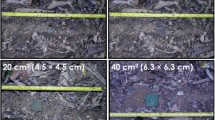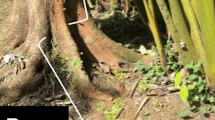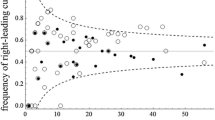Abstract
Morphological castes occur throughout ant species, but their role in task partitioning and colony success remains controversial. Task partitioning based on size is thought to increase colony efficiency, but tests of this hypothesis are difficult. In this study, we delve into the role of different morphological castes of Atta cephalotes in the maintenance of trunk trails, a task considered very important to foraging efficiency in leafcutters. Using differently sized dead and live leaves as obstacles, we tested for evidence of size matching by performing sixty trials in which we recorded the involvement of different castes and the effect of removal of majors on obstacle removal in one A. cephalotes colony. Ants treated live and dead leaves in the path identically. Cutting and pulling of larger leaves involved more ants (of all size castes), and took longer. Removal of the majors (22% of all workers involved) did not negatively impact removal time of obstacles of any size. We hypothesized that there would be matching between ant size and the size of the obstacle removed, but we found no evidence for such matching. Mediae were more likely to pull than minors. When the majors were removed, the minors and mediae increased in cutting and pulling leaves to compensate, with the mediae particularly increasing in pulling. Overall, our results suggest that minors and mediae differ in task partitioning for obstacle removal, and that castes can respond flexibly to removal of other castes. However, we found no evidence that morphological castes improve capacities for trail clearing.



Similar content being viewed by others
References
Beshers SN, Fewell JH (2001) Models of division of labor in social insects. Annu Rev Entomol 46:413–440. doi:10.1146/annurev.ento.46.1.413
Brown JJ, Traniello JFA (1998) Regulation of brood-care behavior in the dimorphic castes of the ant Pheidole morrisi (Hymenoptera: Formicidae): effects of caste ratio, colony size, and colony needs. J Insect Behav 11:209–219. doi:10.1023/A:1021043923311
Calabi P, Traniello JFA (1989) Social organization in the ant Pheidole dentata: physical and temporal caste ratios lack ecological correlates. Behav Ecol Sociobiol 24:69–78
Clark E (2006) Dynamic matching of forager size to resources in the continuously polymorphic leaf-cutter ant, Atta colombica (Hymenoptera, Formicidae). Ecol Entomol 31:629–635. doi:10.1111/j.1365-2311.2006.00826.x
Da-Silva AC, Navas CA, Ribeiro PL (2012) Dealing with water deficit in Atta ant colonies: large ants scout for water while small ants transport it. Biol Open 1:827–830. doi:10.1242/bio.2012703
Dussutour A, Beshers S, Deneubourg JL, Fourcassié V (2007) Crowding increases foraging efficiency in the leaf-cutting ant Atta colombica. Insectes Soc 54:158–165. doi:10.1007/s00040-007-0926-9
Evison SEF, Ratnieks FLW (2007) New role for majors in Atta leafcutter ants. Ecol Entomol 32:451–454. doi:10.1111/j.1365-2311.2007.00877.x
Evison SEF, Hart AG, Jackson DE (2008) Minor workers have a major role in the maintenance of leafcutter ant pheromone trails. Anim Behav 75:963–969. doi:10.1016/j.anbehav.2007.07.013
Farji-Brener AG, Amador-Vargas S, Chinchilla F, Escobar S, Cabrera S, Herrera MI, Sandoval C (2010) Information transfer in head-on encounters between leaf-cutting ant workers: food, trail condition or orientation cues? Anim Behav 79:343–349. doi:10.1016/j.anbehav.2009.11.009
Fjerdingstad EJ, Crozier RH (2006) The evolution of worker caste diversity in social insects. Am Nat 167:390–400. doi:10.1086/499545
Fowler HG (1978) Foraging trails of leaf-cutting ants. J N Y Entomol Soc 86:132–136
Garret RW, Carlson KA, Goggans MS, Nesson MH, Shepard CA, Schofield RMS (2016) Leaf processing behaviour in Atta leafcutter ants: 90% of leaf cutting takes place inside the nest, and ants select pieces that require less cutting. R Soc Open Sci. doi:10.1098/rsos.150111
Hart AG, Anderson C, Ratnieks FL (2002) Task partitioning in leafcutting ants. Acta ethologica 5:1–11. doi:10.1007/s10211-002-0062-5
Hasegawa E (1993) Caste specialization in food storage in the dimorphic ant Colobopsis nipponicus (Wheeler). Insectes Soc 40:261–271. doi:10.1007/BF01242362
Helanterä H, Ratnieks FLW (2008) Geometry explains the benefits of division of labour in a leafcutter ant. Proc R Soc Lond B Biol Sci 275:1255–1260. doi:10.1098/rspb.2008.0024
Hodgson ES (1955) An ecological study of the behavior of the leaf-cutting ant Atta cephalotes. Ecology 36:293–304. doi:10.2307/1933235
Hölldobler B, Wilson EO (1990) The ants. Harvard University Press, Cambridge
Hölldobler B, Wilson EO (2011) The leafcutter ants: civilization by instinct. W.W. Norton & Company, New York
Howard JJ (2001) Costs of trail construction and maintenance in the leaf-cutting ant Atta columbica. Behav Ecol Sociobiol 49:348–356. doi:10.1007/s002650000314
Lanan M (2014) Spatiotemporal resource distribution and foraging strategies of ants (Hymenoptera: Formicidae). Myrmechol News 20:53–70
Lewis T, Pollard GV, Dibley GC (1974) Rhythmic foraging in the leaf cutting ant Atta cephalotes (L.) (Formicidae: Attini). J Anim Ecol 43:129–141
Lugo AE, Farnworth EG, Pool D, Jerez P, Kaufman G (1973) The impact of the leaf cutter ant Atta colombica on the energy flow of a tropical west forest. Ecology 54:1292–1301. doi:10.2307/1934191
Nichols-Orians CM, Schultz JC (1989) Leaf toughness affects leaf harvesting by the leaf cutter ant, Atta cephalotes (L.) (Hymenoptera: Formicidae). Biotropica 21:80–83. doi:10.2307/2388446
O’Hara RB, Kotze DJ (2010) Do not log-transform count data. Methods Ecol Evol 1:118–122. doi:10.1111/j.2041-210X.2010.00021.x
Oster GF, Wilson EO (1978) Caste and ecology in the social insects. Princeton University Press, Princeton
Powell S, Tschinkel WR (1999) Ritualized conflict in Odontomachus brunneus and the generation of interaction-based task allocation: a new organizational mechanism in ants. Anim Behav 58:965–972. doi:10.1006/anbe.1999.1238
Ravary F, Lecoutey E, Kaminski G, Châline N, Jaisson P (2007) Individual experience alone can generate lasting division of labor in ants. Curr Biol 17:1308–1312. doi:10.1016/j.cub.2007.06.047
Robinson GE (1992) Regulation of division of labor in insect societies. Annu Rev Entomol 37:627–665. doi:10.1146/annurev.en.37.010192.003225
Rockwood LL, Hubbell SP (1987) Host-plant selection, diet diversity, and optimal foraging in a tropical leafcutting ant. Oecologia 74:55–61. doi:10.1007/BF00377345
Schmid-Hempel P (1992) Worker castes and adaptive demography. J Evol Biol 5:1–12. doi:10.1046/j.1420-9101.1992.5010001.x
Schwander T, Rosset H, Chapuisat M (2005) Division of labour and worker size polymorphism in ant colonies: the impact of social and genetic factors. Behav Ecol Sociobiol 59:215–221. doi:10.1007/s00265-005-0027-6
Seid MA, Traniello JFA (2006) Age-related repertoire expansion and division of labor in Pheidole dentata (Hymenoptera: Formicidae): a new perspective on temporal polyethism and behavioral plasticity in ants. Behav Ecol Sociobiol 60:631–644. doi:10.1007/s00265-006-0207-z
Sempo G, Detrain C (2010) Social task regulation in the dimorphic ant, Pheidole pallidula: the influence of caste ratio. J Insect Sci 10:1–16. doi:10.1673/031.010.0301
Stradling DJ (1978) The influence of size on foraging in the ant, Atta cephalotes, and the effect of some plant defence mechanisms. J Anim Ecol 47:173–188. doi:10.2307/3930
Traniello JFA, Rosengaus RB (1997) Ecology, evolution and division of labour in social insects. Anim Behav 53:209–213. doi:10.1006/anbe.1996.0289
Waddington SJ, Hughes WOH (2010) Waste management in the leaf-cutting ant Acromyrmex echinatior: the role of worker size, age and plasticity. Behav Ecol Sociobiol 64:1219–1228. doi:10.1007/s00265-010-0936-x
Wetterer JK (1994) Forager polymorphism, size-matching, and load delivery in the leaf-cutting ant, Atta cephalotes. Ecol Entomol 19:57–64. doi:10.1111/j.1365-2311.1994.tb00390.x
Wetterer JK (1999) The ecology and evolution of worker size-distribution in leaf-cutting ants (Hymenoptera: Formicidae). Sociobiology 34:119–144
Wilson EO (1980) Caste and division of labor in leaf-cutter ants (Hymenoptera: Formicidae: Atta): I. the overall pattern in A. sexdens. Behav Ecol Sociobiol 7:143–156
Wilson EO (1983a) Caste and division of labor in leaf-cutter ants (Hymenoptera: Formicidae: Atta): III. Ergonomic resiliency in foraging by A. cephalotes. Behav Ecol Sociobiol 14:47–54. doi:10.1007/BF00366655
Wilson EO (1983b) Caste and division of labor in leaf-cutter ants (Hymenoptera: Formicidae: Atta): IV. Colony ontogeny of A. cephalotes. Behav Ecol Sociobiol 14:55–60. doi:10.1007/BF00366656
Wilson EO (1984) The relation between caste ratios and division of labor in the ant genus Pheidole (Hymenoptera: Formicidae). Behav Ecol Sociobiol 16:89–98. doi:10.1007/BF00293108
Wilson EO (1987) Causes of ecological success: the case of the ants. J Anim Ecol 56:1–9. doi:10.2307/4795
Acknowledgements
We thank Meghan Duell for species identifications and helpful guidance during the development of the study; and members of Jennifer Fewell’s lab for comments that greatly improved the manuscript. We also thank the Smithsonian Tropical Research Institute (STRI) for providing infrastructure and general support for field research. Jon Harrison’s work on this project was partially supported by the National Science Foundation, NSF 13033608.
Author information
Authors and Affiliations
Corresponding author
Rights and permissions
About this article
Cite this article
Cevallos Dupuis, E., Harrison, J.F. Trunk trail maintenance in leafcutter ants: caste involvement and effects of obstacle type and size on path clearing in Atta cephalotes . Insect. Soc. 64, 189–196 (2017). https://doi.org/10.1007/s00040-016-0530-y
Received:
Revised:
Accepted:
Published:
Issue Date:
DOI: https://doi.org/10.1007/s00040-016-0530-y




